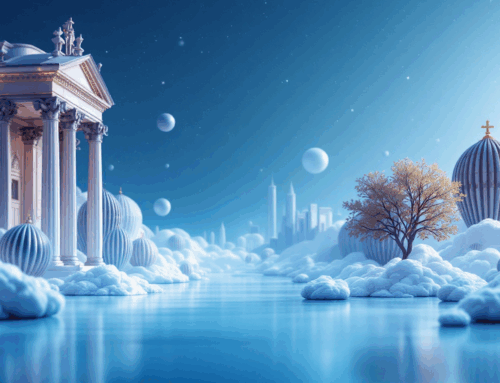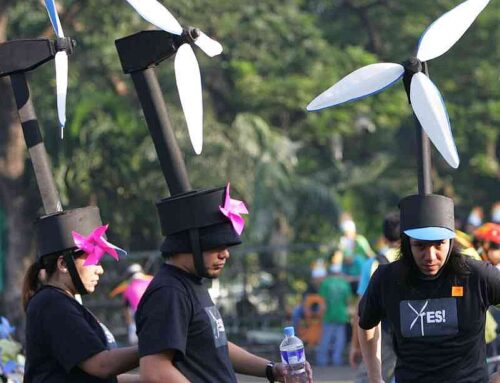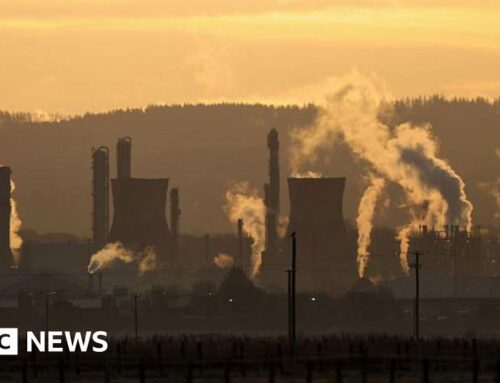I traveled the world studying climate change. To my surprise, I found reason to hope.
April 15, 2025
In 2019, I began investigating our realistic hopes for reversing the bad numbers that kept soaring along with the temperature.

You wouldn’t cover an apple with plastic wrap, then leave it in the sun. Pretty soon it would get warm, then soft. Then develop those mushy brown spots. Then rot.
So why would anyone do that to their planet?
Pretty much, it’s the same: We’ve shrink-wrapped ourselves in transparent layers of invisible CO2, methane, and nitrous oxide. Each year, temperatures set frightening new records.
Fixing this won’t be as easy as ripping away plastic film — gases aren’t easy to grip. Plus, we’re not the only species feeling the heat: so do those that pollinate our food, break down our wastes, enrich our soil, and fill our plates. Put it this way: We co-evolved with them. Not only ecologists, but our religions warn that we can’t have a world without them. But between climate cues gone askew and natural haunts subsumed by sprawl and croplands, we’re losing species faster than scientists can count.
In 2019, I began investigating our realistic hopes for reversing the bad numbers that kept soaring along with the temperature, such as millions of refugees fleeing drought, floods, flames, or unbearable heat. Could we rein in climate change before it waxes out of control, at least enough to give us time to adapt? Raise enough food for everyone without synthetic fertilizer, a major perpetrator of global warming and downstream disasters? Staunch the loss of our brethren species? (Already, 96 percent of mammalian weight is either us or our livestock.)
A dozen countries, one global pandemic, and a brief stint in jail later (I was reporting on protesters chained to a tar-sands oil pipeline being rammed through Ojibwe country in Minnesota when an overzealous sheriff nabbed me), to my surprise I learned that: maybe yes. Everywhere I researched my new book, Hope Dies Last, I met ingenious, inspiring, visionary people — engineers, scientists, farmers, architects, Indigenous elders, Gen Z futurists, even the military — determined to find us a viable future. Here’s a sampling of what encourages me that this human work in progress isn’t over yet:
1) Marjan Minnesma, founder of the Dutch NGO Urgenda, got 886 co-plaintiffs to join her in suing the Netherlands for not protecting its citizens against the ravages of climate change. They not only won, but Urgenda was ready with a 54-point plan — ranging from LEDs in greenhouses to extinguishing workplace lights after-hours — that in 2020 helped to begin the court-ordered cutting of Dutch carbon emissions by 25 percent. Urgenda is now challenging the government with its next plan: a 100 percent sustainable, affordable national energy supply by 2030.
2) In one of Earth’s poorest places, a Rohingya refugee camp in Bangladesh, I saw a solar-and-battery-powered Wi-Fi network that let people living in stifling one-room huts trade and share energy with their neighbors to power fans and lightbulbs, and charge mobile phones. Each cluster of huts connected to surrounding clusters, and so on — all without power lines. This peer-to-peer network’s creator, Dhaka-based SOLshare, is now outfitting and connecting Bangladesh’s 3 million-plus electric rickshaws with solar-rechargeable batteries, whose remaining juice each night will help feed the national grid.
3) Could utility-based energy also go clean? Look no farther than Commonwealth Fusion Systems in Devens, which spun off from an MIT plasma physics class that achieved a technological breakthrough in a former Nabisco cracker factory. It’s leading the international race in carbon-free, nonradioactive fusion — like the energy that makes stars shine. The company is now building a prototype for a fusion plant that will fit a coal-fired plant’s footprint, connect to existing transmission lines, and be cost-competitive, mass-producible, and easily assembled and serviced by any competent contractor. If it succeeds, a cup of sea water could power your life for a year, pollution-free.
4) Celebrated plant breeder Molly Jahn (think Delicata squash), convinced that agriculture must stop plowing habitats and being addicted to chemicals, has proposed using microbes to pull food from thin air. The US Department of Defense is now funding development of a portable system to let bivouacked soldiers make tasty meals from fermented bacteria and atmospheric nitrogen, hydrogen, and CO2. Someday, Jahn predicts, everyone’s kitchen can be a farm.
5) In Iraq’s Mesopotamian cradle of civilization, dictator Saddam Hussein had drained the vast Tigris-Euphrates marshes — the biggest wetland in the Middle East, which some archeologists believe is the remnant Garden of Eden — to flush out Shi’ite rebels. When Hussein was deposed a decade later, in 2003, biologists declared it too desiccated to revive, but locally raised civil engineers Azzam Alwash and Jassim Al-Asadi insisted they couldn’t know that without trying.
After two years of fruitlessly begging for international assistance, for $30 they rented earthmoving equipment and punched through Hussein’s main diversion dike themselves. Two months later, green reed shoots appeared. Today, returning plants, fish, reptiles, and mammals have restored a functioning ecosystem and a mecca for migratory birds, and have welcomed home thousands of Ma’dan: marsh-dwellers who’ve raised water buffalo there since Sumerian times.
6) Back in the United States, I entered wildlife preserves and federal courtrooms with the Tucson-based Center for Biological Diversity, which, wielding one of the world’s most powerful environmental laws, the Endangered Species Act, has sued more than 900 times on behalf of animal and plant life, from polar bears to orchids to slugs, and won 83 percent of its cases. President Nixon signed that act, but now President Trump threatens to defang it, along with protections for forests, waters, and the climate. Whether he can depends on Congress, which so far has let him break laws with impunity. But he can’t break laws of physics.
Monster tornadoes, superstorms, mega-infernos, bomb cyclones, and atmospheric rivers are showing us what overheating the atmosphere does. Presidents can hide in bunkers, but most voters can’t. Next time, I predict they’ll know what to do.
Alan Weisman is a writer in Western Massachusetts. His new book, Hope Dies Last: Visionary People Across the World, Fighting to Find Us a Future, will be published April 22 by Dutton. Send comments to magazine@globe.com.
Search
RECENT PRESS RELEASES
Related Post




